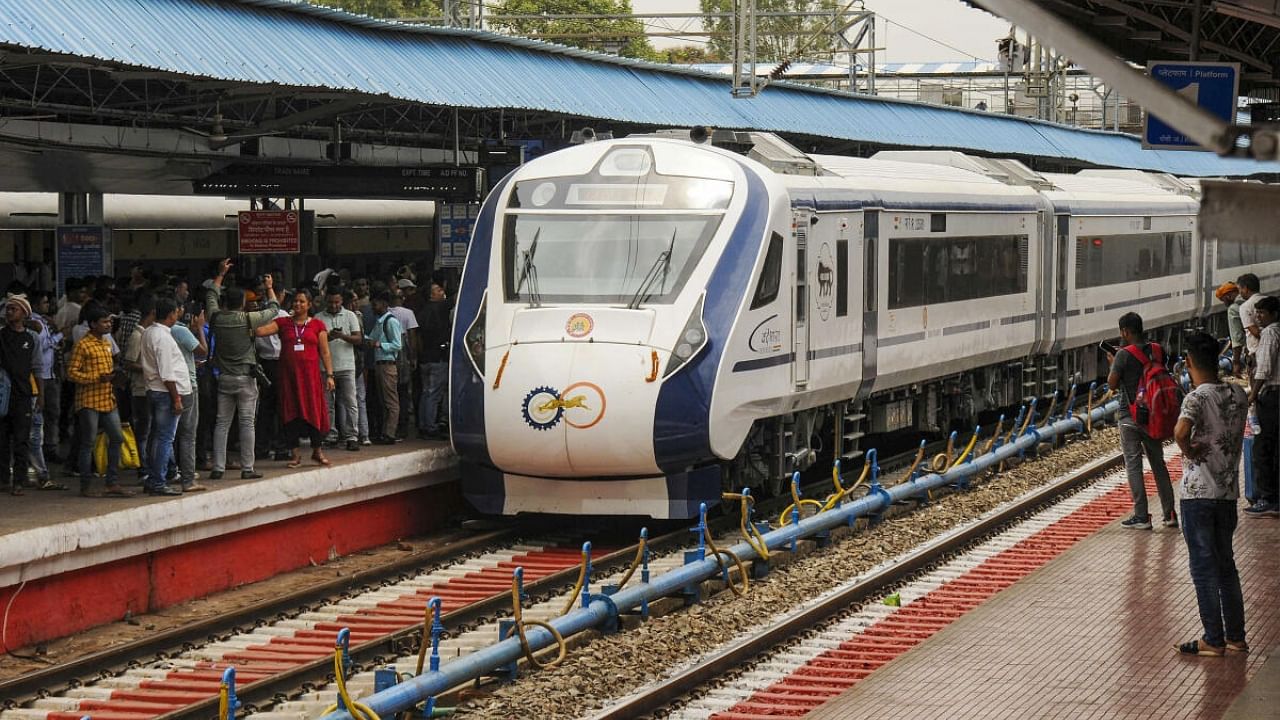
Representative image of a Vande Bharat train.
Credit: PTI Photo
Having travelled in the Vande Bharats, treated as ‘poster train sets’ by the Rail Ministry and personally inaugurated by the Prime Minister either in person or virtually, I couldn’t help but feel disenchanted by the constraints faced by the railways. The constraints include railway track speed capacity, unnecessary forced stoppages, and traffic congestion, which result in limiting the train’s operating speeds to 160 kmph on certain sections, with most of the journey occurring at speeds within the range of 110–130 kmph. Similarly, the chutzpah surrounding technological feats, such as running a train through a rail tunnel and a station under the Hooghly River, seemed a tad out of place.
There are serious issues that plague the Indian Railways and can’t be wished away. It’s not just an opaque babu culture that hinders progress; other problems like politically subsidised passenger tariffs continue to be a significant challenge. Passengers who can afford it are increasingly opting for road travel and air travel for short and long hauls, respectively. India relies heavily on road transportation for freight, with a 50% share compared to China’s 30%, which cripples rail revenues. Moreover, over 80% of the expenditure in the Rail Budget is allocated to wages and salaries, diverting attention from the core issue of rail safety, as the focus often shifts to populist initiatives like catering, providing WiFi, or operating trains below their design speeds.
During a recent journey on the Sri Lankan Railways (a British legacy much like the Indian Railways), I boarded the ‘Udarata Menike’ express train that runs from Colombo Fort station to Nanu Oya. I looked forward to one of the world’s most thrilling rail journeys. The scenic train ride is a must-do experience when visiting Sri Lanka, offering views that were just incredible! The train weaves in and out of emerald-green tea gardens with thickets of tropical rainforests, passing waterfalls, small pools, and brooklets, and going over stone arch bridges surrounded by colourful villages.
While the stations in Sri Lanka were relatively cleaner, thanks to the citizens’ penchant for cleanliness, obtaining information about platform assignments and train schedules proved to be a challenge. There was only one operating electronic board at the station, which lacked the train number and name, displaying only the start and final destinations with timings. Travellers had to analyse and deduce the correct platform. The station staff, much like their counterparts worldwide, were unhelpful, making it difficult to locate your train, the
platform, the coach number, and the seat.
The Sri Lankan Railway is struggling with modernization, electrification, and the extension of lines for faster train movement and improved efficiency while overcoming issues related to passenger comfort, timeliness, and rail accidents. The coaches were made in China and had reclining seats, automatic doors, TVs, and other comforts comparable to those on the Vande Bharat. However, the train ride was far from smooth. The Vande Bharat’s propulsion motors mounted on alternate coaches ensure no jolts the way the Chinese coaches jerk. Perhaps the tracks were too bumpy and required relaying because whenever the locomotive accelerated or decelerated, the jolts caused my coffee to spill multiple times.
The train drivers and station masters looked gallant in their white uniforms, manning quaint stations reminiscent of colonial times. At Kandy, a junction en route, the train had to move backwards to exit the station, while at Gambola, another station, the train moved backwards apparently because it was on the wrong platform. An accident caused the train to move backwards a third time. A local villager sitting with his feet across the tracks forced the engine driver to come to a screeching halt, but not before running over the man’s legs. An improvised stretcher brought the injured man into the train, which moved backwards again to the Kalapitiya station and the nearest available hospital. Single-track movement on wooden sleepers held up our express an umpteen number of times to allow other trains to cross over. Electronic signalling being nonexistent, the primitive interlocking colour-light system with electrically operated points with level crossings connected to the signalling system ensured safety. When we
finally reached it, the train had reversed three times, taking more than 8 hours to cover a distance of 180 odd kilometres at an average speed of 22 kmph!
After experiencing the train system in Sri Lanka, I was open to looking kindly at our own railway system. Yes, in order to get better, we must compare ourselves with the rail systems in Japan or Germany, but until we get there, let’s think of our friendly neighbour’s railway and realise we are definitely better off!
(The writer is a former Executive Director and Member, Board of Directors, BEML)